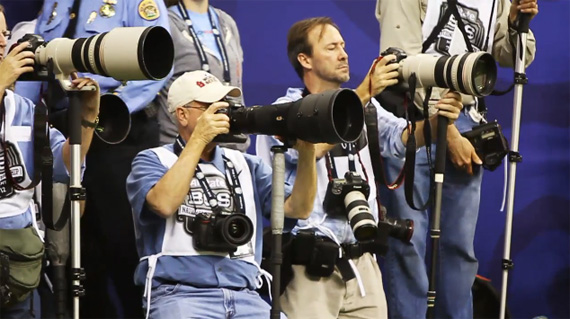Paying a visit to New Orleans, this segment catches up with four Sports Illustrated Photographers assigned to cover the 2012 BCS National Championship to discuss photographing professional football.This video is chock full of tips and pointers aspiring sports photographers can use to hone their skills. Damian Strohmeyer, Al Tielemans, Simon Bruty, and John Biever deliver their personal takes on what it takes to capture great sports photographs. Watch the interview here:
The group, though interviewed separately, unanimously agreed that teamwork is a great part of covering such large sporting events. For the National Championship, the men were spread out around the field, with Simon Bruty taking position above the field from the catwalk. Having no special equipment, or time, to communicate with one another, the photographers use educated guesses to know the position of one another, helping them capture the best shots of a play as a team. All the men agree a good amount of risk taking and luck is involved, but not without preparation, position, and the ability to predict what is going to happen next.
“There are so many good sports pictures these days that something has to standout. It’s generally something that isn’t normal sizing, its either high, low, tight, or wide,” says the veteran photographer of the group John Biever, who has photographed every single Super Bowl since 1967.

Professional Football Photographers
Let’s not forget, serious photographers require serious equipment. Bruty suggests starting with a minimum of a 300mm lens and building up your collection to also include a 400 f/2.8, 500 f/2.8, and a 600 f/4. He also stresses the importance of using a monopod when shooting on any lens 300mm or longer. Take a look at the gear list the team used to shoot the Championship.
Al Tielmans and John Biever used the following Nikon gear:
- Nikon D3 DSLR Camera (soon to be Nikon D4)
- Nikkor 14-24 2.8
- Nikkor 24-70 2.8
- Nikkor 70-200 2.8 VRII
- Nikkor 300 2.8 VRII
- Nikkor 400 2.8 VR
- Nikkor 500 f4 VRII
- Nikkor 600 f4 VR
- Nikkor 200 – 400 f4
- Various Nikkor Teleconvertors
Simon Bruty and Damien Strohmeyer shot on Canon gear:
- Canon 1D Mark IV DSLR Body
- Canon 16-35 2.8L II
- Canon 24-70 2.8L II
- Canon 70 – 200 2.8L II
- Canon 300 2.8L II
- Canon 400 2.8L II
- Soon Canon 500 f4 II
- Various Canon EF Extenders
It is a difficult and expensive field to get into, but being passionate and competitive can help you rise to the most competitive level of sports photography. When you get a credential and you are down on the field, you have as good a chance as anyone to capture the “shot of the game.”
Like This Article?
Don't Miss The Next One!
Join over 100,000 photographers of all experience levels who receive our free photography tips and articles to stay current:






Kwame Rotimi Jantuah,you first need to have solid understand about you camera,you need to understand the camera setting (exposure triangle) also you need to have knowledge about football so you never miss shots of important events in a match
Good Morning,
My Name is Kwame Rotimi Jantuah, I am 17 years of age currently doing media at west herts college I was wondering what qualifications do I need to become a sports photographer and take photos for a football club.
please get back to me if you have any sports photographers who can answer my questions please let me know how i can get in touch with them
Sincerely
Kwame
I found these tips extremely useful, thanks for sharing.